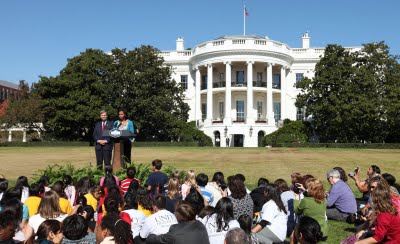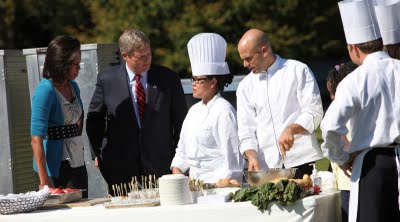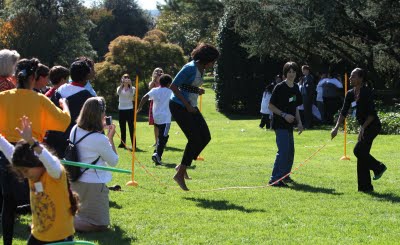Cross-posted from Obama Foodorama.
 Secretary of Agriculture Tom Vilsack watches Mrs. Obama make remarks at the opening of the Fair.Photo: Obama FoodoramaA challenge for change, and White House Chefs demo’ing delicious, nutritious recipes…
Secretary of Agriculture Tom Vilsack watches Mrs. Obama make remarks at the opening of the Fair.Photo: Obama FoodoramaA challenge for change, and White House Chefs demo’ing delicious, nutritious recipes…
The autumn sunshine was very bright, the weather unseasonably warm, and there was a party atmosphere at the White House for Wednesday’s Healthy Kids Fair. First Lady Michelle Obama kicked off her shoes and hula hooped, Double Dutch jump roped, and sprinted through an obstacle course on the South Lawn, accompanied by dozens of visiting school children. Meanwhile, White House Chefs, and a few high-profile guest chefs, whipped up recipes at a series of outdoor kitchen stations.
That fun side of the the Healthy Kids Fair was reported by mainstream media. But the event couldn’t have been more serious.
 Michelle Obama hola hooping.Photo: Obama FoodoramaThe Healthy Kids Fair is part of an ongoing Obama campaign to encourage kids, parents, and families to make changes in their behavior that will improve overall health. It was a way of continuing the national conversation about children’s health and nutrition issues that Mrs. Obama started last spring, when she first planted the White House Kitchen Garden.
Michelle Obama hola hooping.Photo: Obama FoodoramaThe Healthy Kids Fair is part of an ongoing Obama campaign to encourage kids, parents, and families to make changes in their behavior that will improve overall health. It was a way of continuing the national conversation about children’s health and nutrition issues that Mrs. Obama started last spring, when she first planted the White House Kitchen Garden.
In her remarks at the Healthy Kids Fair, Mrs. Obama repeated the grave statistics that have become part of her food policy speeches: one in three American children is overweight or obese, and for the first time ever medical experts predict that unless the trend is reversed the current generation of children will have a shorter life span than their parents, due to diet-related disease. Then the First Lady pointed out something she hasn’t previously mentioned in any of her speeches: Children spend a third of their time in schools, and many schools are undermining parents’ best efforts to keep their kids healthy.
“…We don’t have control over what you eat when you’re at school,” Mrs. Obama told the children seated on the grass in front of her. And then she addressed the parents. “So even when we’re — when we’re working hard to give our kids healthy food at home, if they go to school and eat a lunch that’s loaded with calories and fat, then all the efforts that we try to instill at home, it gets knocked off a little bit.”
Mrs. Obama noted cutbacks in recess and physical education as another way in which school policies can undermine parents and compromise children’s health:
“When I grew up — and I went to public schools in my neighborhood — I don’t care what you did; you had recess and you had gym on a very regular basis,” Mrs. Obama said. “So even though we’re encouraging our kids to exercise, if they can’t go to school and … get the same kind of exercise opportunities, then it makes our jobs as parents harder.”
No PE/recess and bad school foods are not solely to blame for the rising rates of child obesity, but they sure don’t help. At the Healthy Kids Fair, Mrs. Obama and Secretary of Agriculture Tom Vilsack praised the USDA’s Healthier U.S. Schools Challenge. The program has been embraced by about 635 elementary schools nationwide, which have pledged to eliminate junk foods from their campuses, make healthy foods available, include nutrition education in the curriculum, and re-introduce physical activity, either by adding recess or physical education classes. Mrs. Obama and the USDA are working together to dramatically expand the program by bringing it into middle and high schools.
Better school lunches are already possible
 Mrs. Obama, Sec. Vilsack, Comerford, and Kass confer while Kass mixes eggs.Photo: Obama FoodoramaAnother tidbit that went largely unreported from the Healthy Kids Fair was what those White House and guest chefs were cooking. They weren’t just preparing random “fun” recipes; they were making nutritious, low fat, healthy dishes with ingredients that are already available to schools through the USDA’s federal nutrition program. Mrs. Obama pointed this out in her remarks:
Mrs. Obama, Sec. Vilsack, Comerford, and Kass confer while Kass mixes eggs.Photo: Obama FoodoramaAnother tidbit that went largely unreported from the Healthy Kids Fair was what those White House and guest chefs were cooking. They weren’t just preparing random “fun” recipes; they were making nutritious, low fat, healthy dishes with ingredients that are already available to schools through the USDA’s federal nutrition program. Mrs. Obama pointed this out in her remarks:
“ The chefs and nutritionists here today are going to show us how we can use the food that the USDA provides to schools as a way to prepare really tasty, healthy foods,” Mrs. Obama said. “They’re going to take that food that you get in the schools and do some special stuff to show that with the food that we have, we can probably do even better than we’re doing.”
The event was a way of graphically illustrating that it’s possible to do a school food policy end run right now — and improve child nutrition immediately. Staging a cooking demonstration like this at the White House was a subtle way of saying that bad school meals can’t be blamed solely on the USDA’s current policies. Unhealthy practices have to do with the choices schools are making — and parents are allowing.
The point is, it’s possible to do things much, much better, and the White House and the USDA want to encourage this kind of initiative. Baltimore’s school system, for example, has a terrific nutrition program, led by Tony Geraci. It’s a good example of what happens when parents and school systems work together for change. USDA’s new Know Your Farmer, Know Your Food project, which re-focuses already available federal funding on local sourcing and farm-to-school initiatives, is another effort that can help parents and students make changes. Certainly, some of the federal standards for foods allowed into the nutrition programs must change, but it’s not the completely hopeless disaster that it’s often made out to be by food policy wonks.
Making change fun, and focusing on the positive…
 The airborne First Lady skips rope on the South Lawn.Photo: Obama FoodoramaThe Healthy Kids Fair was part of a brilliant soft-glove strategy on the part of the White House and the USDA to encourage schools to reform themselves, without depending solely on government intervention — and without waiting for the kinds of battles that can surround changes in policy on the federal level. But in the coming years, as Mrs. Obama and Sec. Vilsack — and people from agencies across the Obama administration — continue to raise the public’s awareness about school health issues, we will eventually arrive at a point in time when schools that haven’t changed will move from being merely contributors to the child obesity epidemic, to being willful perpetrators of it. And considering that the USDA supplies meals for more than 30 million children through its federal feeding programs, this is no small deal. If even a third of American schools get on board with much better health and nutrition programs, this could cause a huge change in the percentage rates of obesity in the population.
The airborne First Lady skips rope on the South Lawn.Photo: Obama FoodoramaThe Healthy Kids Fair was part of a brilliant soft-glove strategy on the part of the White House and the USDA to encourage schools to reform themselves, without depending solely on government intervention — and without waiting for the kinds of battles that can surround changes in policy on the federal level. But in the coming years, as Mrs. Obama and Sec. Vilsack — and people from agencies across the Obama administration — continue to raise the public’s awareness about school health issues, we will eventually arrive at a point in time when schools that haven’t changed will move from being merely contributors to the child obesity epidemic, to being willful perpetrators of it. And considering that the USDA supplies meals for more than 30 million children through its federal feeding programs, this is no small deal. If even a third of American schools get on board with much better health and nutrition programs, this could cause a huge change in the percentage rates of obesity in the population.
Emphasizing the fun elements of critical physical activity — such as skipping rope and hula hooping — is a savvy approach to public health initiatives, and makes the dire need for it a bit less shocking. And reminding kids that healthy foods are delicious — as Mrs. Obama did at the event — and which White House chef Sam Kass has repeatedly done with other kids — puts a positive, happy spin on it all. And makes kids far more likely to maintain the behaviors.
“We want to make it a little easier on you all,” said the First Lady in her remarks at the Fair. “Not just tell you what to do and what you should look like, but help you with some resources so that it doesn’t feel so impossible.” There will be more initiatives coming from the White House — and the USDA, and Health and Human Services — and the Education Department. But as the Obamas like to say, government can’t do it all. At the end of the day, personal changes are what will make the biggest difference in personal and public health.
*Read a new report released this week from the federal Institute of Medicine, which notes that changes in school food policies are critical for the health of the current generation, too. In School Meals: Building Blocks For Healthy Children, the IOM calls for more fruits, more vegetables, and more whole grains in school lunches, as well as a reduction of salt, sugar, and fat, and a calorie limit for federally sponsored school lunches and breakfasts. The USDA commissioned the report; changing dietary guidelines in federal programs is crucial.
*Watch Mrs. Obama’s full remarks in the video below, courtesy of the White House. And do note that the First Lady is not calling for a ban on junk foods, or telling people exactly what to eat. She admits, once again, her enduring devotion to French fries, and adds that the First Family loves its burgers. She’s calling for balance and moderation — and encouraging profound change.


